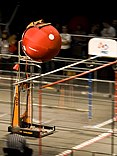
Aim High was the 2006 game for the FIRST Robotics Competition. The competition involved teams competing to gain points by delivering balls into goals and positioning their robots in certain positions on the playing field. The teams took it in turn to provide defense and attack.

Triple Play was the name of the 2005 season FIRST Robotics Competition game.
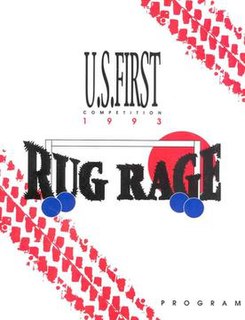
Rug Rage was the 1993 game of the FIRST Robotics Competition. In it, teams competed individually to score as many balls as possible in their goal. As of 2011, it is the only year to see a decrease in the number of teams competing.
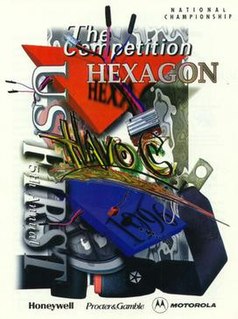
Hexagon Havoc was the 1996 game for the FIRST Robotics Competition. Seeding games of 1-on-1-on-1 were played double-elimination to determine the teams for the finals rounds. In the finals, robots played 1-on-1 in a best 2 out of 3.
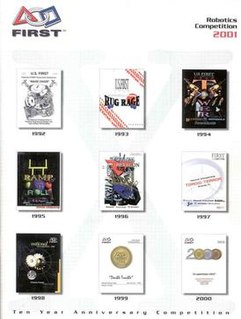
Diabolical Dynamics was the 2001 game for the FIRST Robotics Competition.

FIRST Tech Challenge (FTC), formerly known as FIRST Vex Challenge, is a robotics competition for students in grades 7–12 to compete head to head, by designing, building, and programming a robot to compete in an alliance format against other teams. FIRST Tech Challenge is the one of the four major robotics programs organized by FIRST, which its other three programs include FIRST Lego League Explore, FIRST Lego League Challenge, and FIRST Robotics Competition.

Hangin'-A-Round was the name of the robotics contest at the 2006-2007 FIRST Vex Challenge (FVC). The contest involved building a robot from a kit that could attain a higher score than the opposition by placing the softballs into the colored goals, possessing the “atlas ball”, and by being parked on the platform or hanging from the bar.

Half-Pipe Hustle was the first official FIRST Vex Challenge (FVC) game, taking place in 2005–2006. In this challenge, robotics teams built robots from the Vex design kit to compete in competitions across the United States and in other nations, in matches consisting of a 45-second autonomous period, followed by a 2-minute driver control period in which the robots are controlled by team drivers using remote controls.

Hot Shot! is the robotics competition event in the 2009-2010 FIRST Tech Challenge. Two teams compete to score points by depositing whiffle balls into designated areas.
Get Over It! is the robotics competition event for the 2010-11 FIRST Tech Challenge. Two teams compete to score points by depositing colored batons in various types of goals. The name of the game refers to the many obstacles that traverse the middle of the field, which include a mountain, two bridges, and two ramps.

Logo Motion is the 2011 FIRST Robotics Competition game. Playing pieces are inner tubes shaped like the components of the FIRST logo. The primary objective of the game is to place them on racks to gain points. In the endgame, robots deploy smaller robots ("minibots") to climb a tower. Minibots must be made from the FIRST Tech Challenge kit of parts. The game celebrates the 20th season of the FRC and is also meant to commemorate the artist Jack Kamen, who designed the original FIRST logo.

Bowled Over!, released on 10 September 2011, is the 2011–12 robotics competition for FIRST Tech Challenge. Two alliances compete to score racquetballs into alliance-colored scoring goals. The name refers to two bowling balls on the field used for scoring points.

Ring It Up!, released on 8 September 2012, was the 2012–2013 robotics competition for FIRST Tech Challenge. In the competition, two alliances, each consisting of two teams, competed to score plastic rings on a set of pegs aligned in a three-dimensional tic-tac-toe board. Ring It Up! is the eighth FTC challenge. More than 2400 teams competed worldwide, surpassing the number of competitors in the previous year's Bowled Over! challenge.

Ultimate Ascent was the 2013 FIRST Robotics Competition game. It is styled similarly to disc golf.

Block Party!, released on September 7, 2013, is the 2013–2014 robotics competition for FIRST Tech Challenge. In the competition, two alliances, each consisting of two teams, compete to score blocks in plastic crates atop alliance-colored pendulums. Block Party! is the ninth FTC challenge.
FIRST Stronghold was the 2016 FIRST Robotics Competition game. The game was played by two alliances of up to three teams each, and involves breaching the opponents’ defenses, known as outer work as well as capturing their tower by first firing "boulders" at it, and then surrounding or scaling the tower using a singular rung on the tower wall. Points were scored by crossing elements of the tower's outer works, shooting boulders into the opposing tower's five goals in order to lower the tower strength, and by surrounding and scaling the tower.
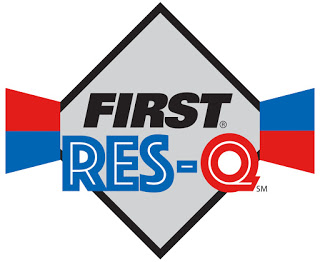
FIRST Res-Q, released on September 8, 2015, is the 2015–2016 robotics competition for FIRST Tech Challenge. In the competition, two alliances, each consisting of two teams, compete to climb a mountain and score debris in alliance specific goals. FIRST Res-Q is the eleventh FTC challenge game.
VEX Robotics is a robotics program for elementary through university students, and a subset of Innovation First International. The VEX Robotics competitions and programs are managed by the Robotics Education and Competition Foundation (REC). In April 2018, VEX Robotics Competition was named the largest robotics competition in the world by Guinness World Records.

FIRST Steamworks, stylized as FIRST STEAMworks, was the FIRST Robotics Competition game for the 2017 season. As in past games, two alliances of three individual teams and their robots compete on a field to score "match" point to win the game and ranking points to advance to playoff rounds. The game has a steampunk theme and teams are required to shoot wiffle balls which represent fuel into a simulated boiler which transfers the generated steam into an airship in the middle of the field. Each alliance has one airship, which they pressurize with steam from the boiler and load with plastic gears from the field. At the end of the match, robots can climb and hang on team-supplied ropes attached to the airship for additional points.

Rover Ruckus, officially known as Rover Ruckus Presented by Qualcomm for sponsorship reasons, is the FIRST Tech Challenge game for the 2018–2019 season. In the competition, two alliances of two teams each compete to collect minerals and place them into the cargo holes of the lander. Rover Ruckus is the fourteenth FTC game.


















